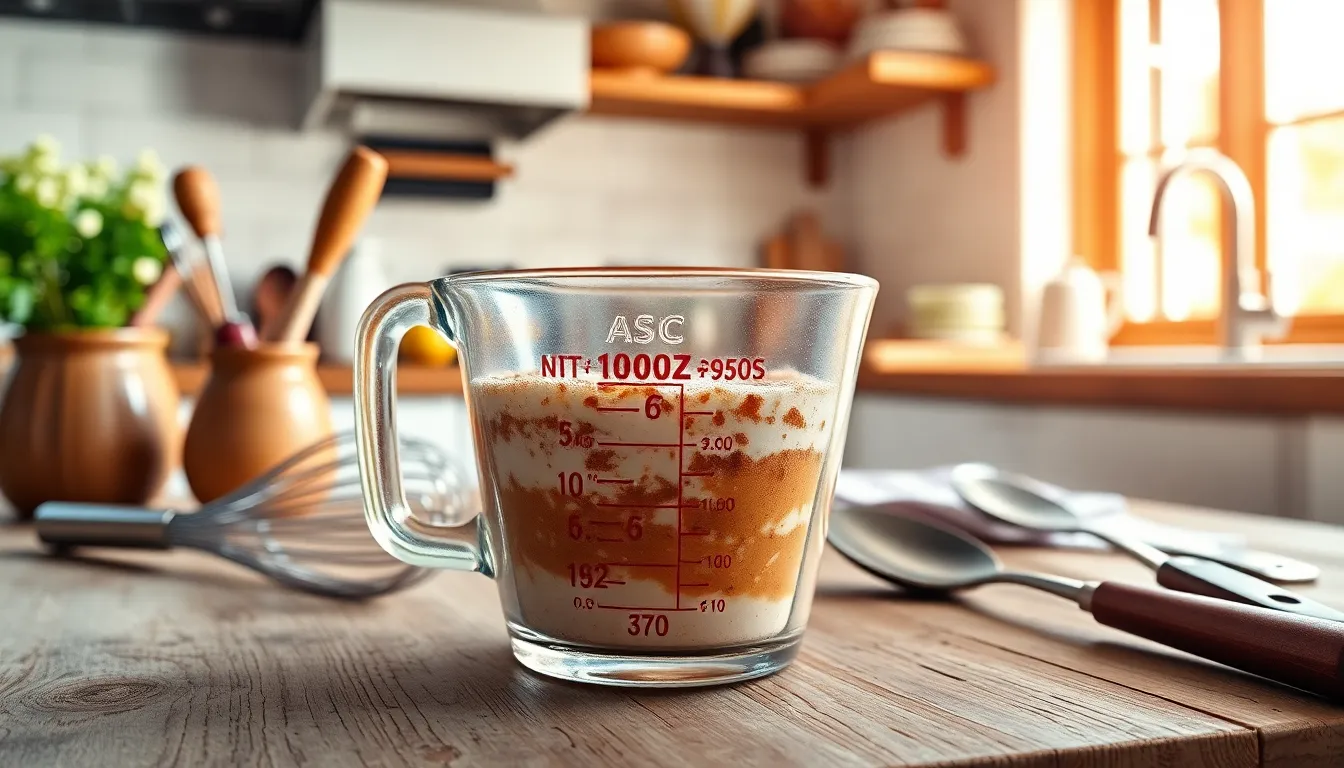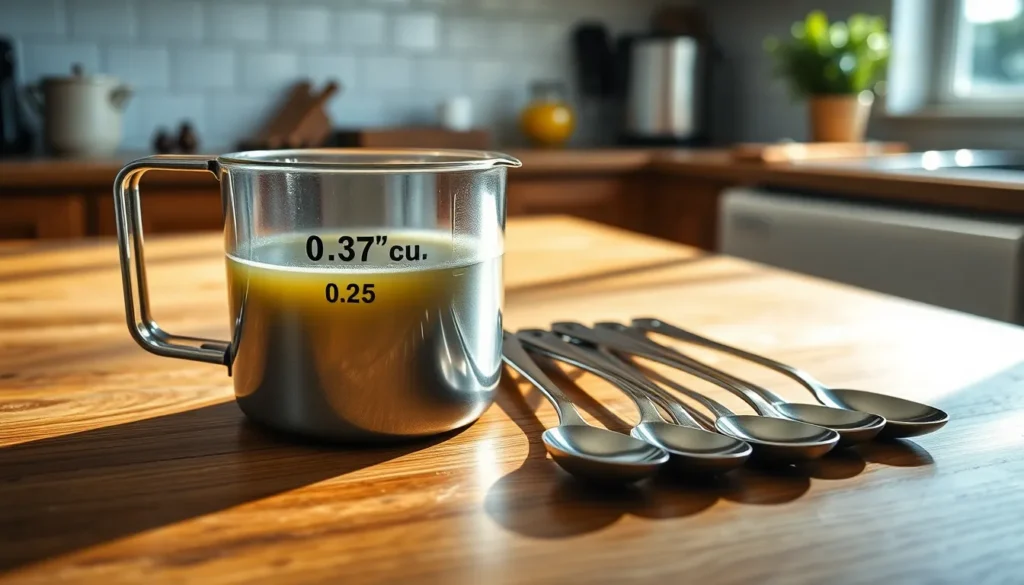When it comes to cooking and baking, precision is key. Understanding measurements can make or break a recipe, especially when it involves ingredients like flour, sugar, or liquids. One common question that arises in the kitchen is how to convert tablespoons to cups.
For those wondering about the conversion of 6 tablespoons into cups, knowing the right amount can help ensure a successful dish. This simple yet essential conversion can save time and reduce confusion, allowing home cooks to focus on what they do best: creating delicious meals. Let’s dive into the specifics of this measurement and unlock the secrets to perfecting culinary creations.
Table of Contents
ToggleUnderstanding Measurement Conversions
Understanding measurement conversions is essential in cooking and baking. Accurate conversions ensure recipe success and enhance culinary skills.
When converting tablespoons to cups, it’s crucial to note that 1 tablespoon equals 0.0625 cups. To convert 6 tablespoons into cups, multiply 6 by 0.0625. This results in 0.375 cups.
| Tablespoons | Cups |
|---|---|
| 1 | 0.0625 |
| 2 | 0.125 |
| 3 | 0.1875 |
| 4 | 0.25 |
| 5 | 0.3125 |
| 6 | 0.375 |
Familiarity with these conversions simplifies various recipes and ensures ingredient accuracy. Using precise measurements leads to consistent results in culinary endeavors.
Tablespoons to Cups Conversion

Understanding tablespoons to cups conversion ensures accuracy in recipes. Accuracy plays a crucial role in culinary success.
The Basics of Volume Measurements
Volume measurements vary based on the measurement system used. In the US customary system, common units include teaspoons, tablespoons, and cups. Specifically, 1 cup equals 16 tablespoons. Recognizing this conversion aids in applying the correct quantities during cooking and baking.
Conversion Formula for Tablespoons to Cups
The conversion formula for tablespoons to cups simplifies measurements. To convert tablespoons to cups, multiply the number of tablespoons by 0.0625. Alternatively, divide the number of tablespoons by 16, as there are 16 tablespoons in a cup. For example, 6 tablespoons multiplied by 0.0625 equals 0.375 cups. This direct conversion provides clarity and enhances recipe execution for home cooks.
| Tablespoons | Cups |
|---|---|
| 1 | 0.0625 |
| 2 | 0.125 |
| 3 | 0.1875 |
| 4 | 0.25 |
| 5 | 0.3125 |
| 6 | 0.375 |
| 7 | 0.4375 |
| 8 | 0.5 |
| 9 | 0.5625 |
| 10 | 0.625 |
| 11 | 0.6875 |
| 12 | 0.75 |
| 13 | 0.8125 |
| 14 | 0.875 |
| 15 | 0.9375 |
| 16 | 1 |
Practical Applications of Converting Tablespoons to Cups
Converting tablespoons to cups proves essential across various cooking and baking scenarios, contributing to more precise measurements and improved culinary outcomes.
Cooking and Baking Scenarios
In cooking and baking, exact measurements play a vital role. Recipes often specify ingredient quantities in tablespoons, particularly for liquids like oils and sauces. For instance, when a recipe calls for 6 tablespoons of olive oil, knowing the conversion to cups simplifies the ingredient preparation process. Since 6 tablespoons equals 0.375 cups, cooks can easily pour and measure without confusion. Recipes for baked goods, such as cakes and cookies, also require careful measuring to achieve the right texture and consistency. Miscalculations can lead to dense cakes or fragile cookies. Utilizing the tablespoons to cups conversion fosters accuracy, ensuring that ingredients blend seamlessly.
Everyday Measurement Needs
In everyday life, converting tablespoons to cups aids in meal prepping and family cooking. Many home cooks rely on standard measuring spoons that include tablespoon measurements. When adapting recipes for larger gatherings, understanding that 6 tablespoons converts to 0.375 cups helps in scaling ingredient portions effectively. For example, doubling a recipe requires knowledge of these conversions for precise results. Furthermore, replacing 6 tablespoons of an ingredient with its cup equivalent can streamline the cooking process, making it more efficient. This practical knowledge enhances time management and encourages more home-cooked meals, ultimately promoting healthier eating habits.
Common Mistakes in Measurement Conversions
Many individuals make common errors while converting tablespoons to cups. Understanding these mistakes helps ensure accuracy in cooking and baking.
- Relying on Estimates: Some cooks estimate the amount instead of using precise measuring tools. This leads to discrepancies in ingredient amounts and affects the final dish.
- Ignoring Differences Between Liquid and Dry Ingredients: Conversions for liquids and dry ingredients aren’t always equivalent. For example, a tablespoon of flour and a tablespoon of water weigh differently, which impacts recipes significantly.
- Misunderstanding the Conversion Factor: Not all tablespoons convert the same way. Failing to remember that 1 tablespoon equals 0.0625 cups often results in incorrect measurements.
- Using the Wrong Measuring Spoon: Using a teaspoon instead of a tablespoon or vice versa can dramatically skew ingredient quantities. This mistake alters the flavor and texture of dishes.
- Not Accounting for Ingredient Density: Some ingredients, like packed brown sugar, differ in density when measuring. Without considering density, cooks risk under or over-measuring.
Correcting these mistakes ensures proper ingredient measurement, enhancing culinary results and overall satisfaction in each cooking endeavor.
Understanding the conversion of 6 tablespoons to 0.375 cups is a simple yet essential skill for any home cook. This knowledge not only aids in accurate ingredient measurement but also enhances the overall cooking experience. By familiarizing themselves with volume measurements and conversion formulas, cooks can avoid common pitfalls and achieve better results in their culinary creations.
Mastering these conversions empowers individuals to tackle a variety of recipes with confidence. Whether preparing a family meal or baking a special treat, precise measurements pave the way for delightful dishes and satisfied taste buds. Embracing this practical knowledge encourages more home-cooked meals and supports healthier eating habits.





